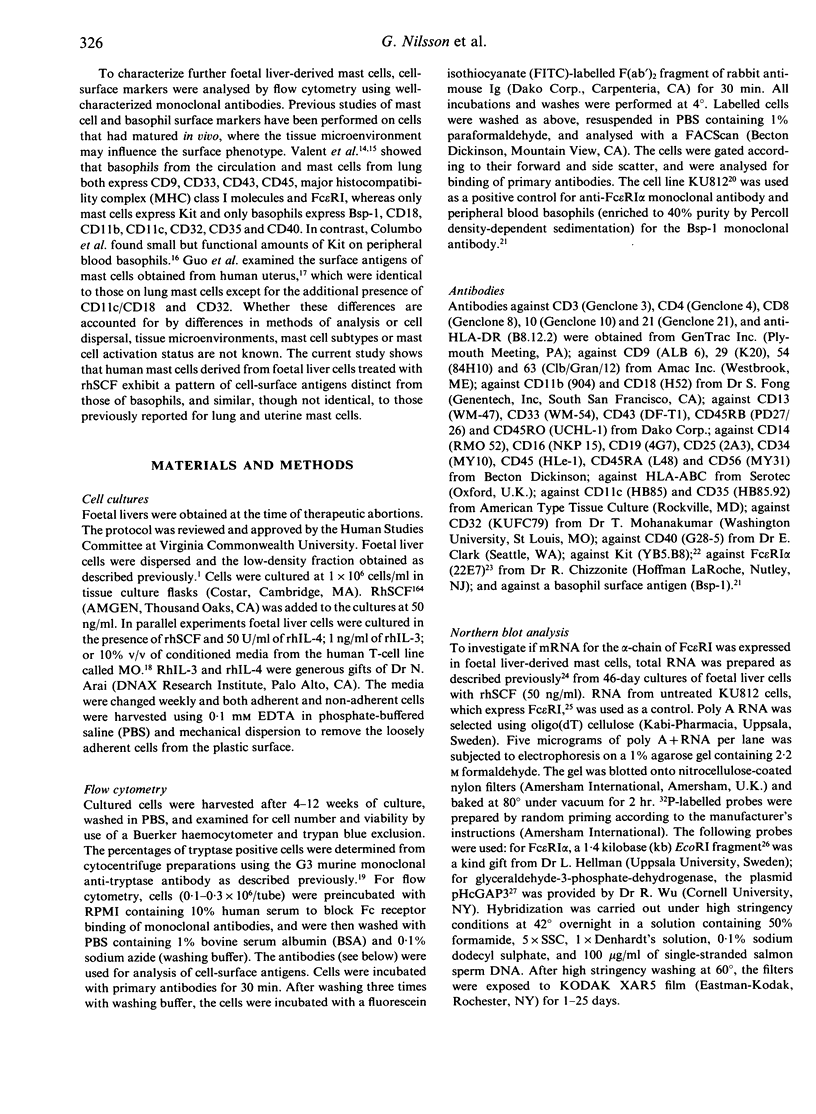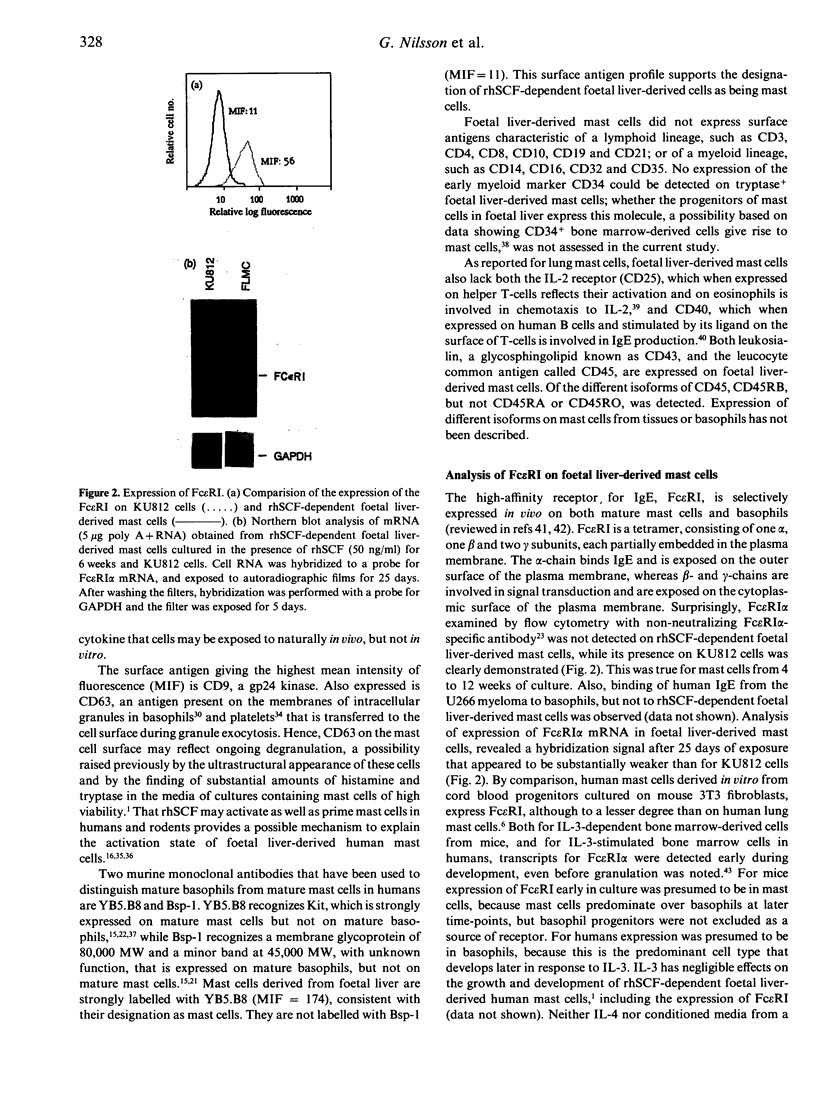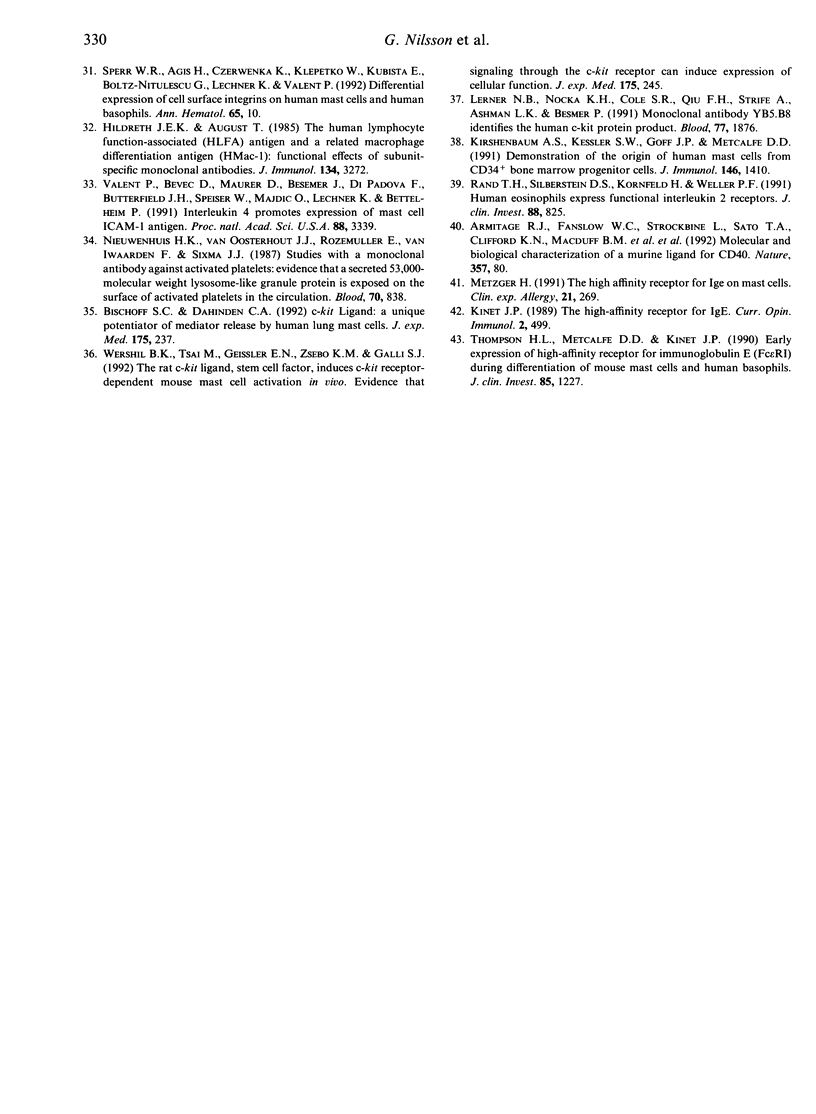Abstract
Human foetal liver cells are an enriched source of mast cell progenitors that complete their differentiation and mature in response to stem cell factor, the ligand for Kit, in liquid culture. These mast cells are Kit+, metachromatic with toluidine blue+, tryptase+, histamine+ and show ultrastructure features of mast cells. Using a panel of monoclonal antibodies (mAb) against different cell-surface antigens (33 mAb were used), the cell-surface phenotype of human stem cell factor-dependent foetal liver-derived mast cells was examined by flow cytometry. Consistent with previous reports on tissue-derived mast cells, those derived from foetal liver in vitro expressed HLA class I, CD9, CD29, CD33, CD43, CD45 and Kit. Unlike mast cells dispersed from tissue, a high expression of CD13 was found. Also, these in vitro-derived mast cells express little, if any, high-affinity IgE receptor. However, small amounts of mRNA for the alpha-chain in foetal liver-derived mast cells compared to KU812 cells (a human basophil-like cell line) could be detected by Northern blotting. Full expression of Fc epsilon RI may require additional growth factor(s).
Full text
PDF





Images in this article
Selected References
These references are in PubMed. This may not be the complete list of references from this article.
- Almlöf I., Nilsson K., Johansson V., Akerblom E., Slotte H., Ahlstedt S., Matsson P. Induction of basophilic differentiation in the human basophilic cell line KU812. Scand J Immunol. 1988 Sep;28(3):293–300. doi: 10.1111/j.1365-3083.1988.tb01451.x. [DOI] [PubMed] [Google Scholar]
- Bischoff S. C., Dahinden C. A. c-kit ligand: a unique potentiator of mediator release by human lung mast cells. J Exp Med. 1992 Jan 1;175(1):237–244. doi: 10.1084/jem.175.1.237. [DOI] [PMC free article] [PubMed] [Google Scholar]
- Blom T., Huang R., Aveskogh M., Nilsson K., Hellman L. Phenotypic characterization of KU812, a cell line identified as an immature human basophilic leukocyte. Eur J Immunol. 1992 Aug;22(8):2025–2032. doi: 10.1002/eji.1830220811. [DOI] [PubMed] [Google Scholar]
- Bodger M. P., Mounsey G. L., Nelson J., Fitzgerald P. H. A monoclonal antibody reacting with human basophils. Blood. 1987 May;69(5):1414–1418. [PubMed] [Google Scholar]
- Chomczynski P., Sacchi N. Single-step method of RNA isolation by acid guanidinium thiocyanate-phenol-chloroform extraction. Anal Biochem. 1987 Apr;162(1):156–159. doi: 10.1006/abio.1987.9999. [DOI] [PubMed] [Google Scholar]
- Columbo M., Horowitz E. M., Botana L. M., MacGlashan D. W., Jr, Bochner B. S., Gillis S., Zsebo K. M., Galli S. J., Lichtenstein L. M. The human recombinant c-kit receptor ligand, rhSCF, induces mediator release from human cutaneous mast cells and enhances IgE-dependent mediator release from both skin mast cells and peripheral blood basophils. J Immunol. 1992 Jul 15;149(2):599–608. [PubMed] [Google Scholar]
- Dvorak A. M., Saito H., Estrella P., Kissell S., Arai N., Ishizaka T. Ultrastructure of eosinophils and basophils stimulated to develop in human cord blood mononuclear cell cultures containing recombinant human interleukin-5 or interleukin-3. Lab Invest. 1989 Jul;61(1):116–132. [PubMed] [Google Scholar]
- Furitsu T., Saito H., Dvorak A. M., Schwartz L. B., Irani A. M., Burdick J. F., Ishizaka K., Ishizaka T. Development of human mast cells in vitro. Proc Natl Acad Sci U S A. 1989 Dec;86(24):10039–10043. doi: 10.1073/pnas.86.24.10039. [DOI] [PMC free article] [PubMed] [Google Scholar]
- Guo C. B., Kagey-Sobotka A., Lichtenstein L. M., Bochner B. S. Immunophenotyping and functional analysis of purified human uterine mast cells. Blood. 1992 Feb 1;79(3):708–712. [PubMed] [Google Scholar]
- Hildreth J. E., August J. T. The human lymphocyte function-associated (HLFA) antigen and a related macrophage differentiation antigen (HMac-1): functional effects of subunit-specific monoclonal antibodies. J Immunol. 1985 May;134(5):3272–3280. [PubMed] [Google Scholar]
- Irani A. A., Craig S. S., Nilsson G., Ishizaka T., Schwartz L. B. Characterization of human mast cells developed in vitro from fetal liver cells cocultured with murine 3T3 fibroblasts. Immunology. 1992 Sep;77(1):136–143. [PMC free article] [PubMed] [Google Scholar]
- Irani A. M., Bradford T. R., Kepley C. L., Schechter N. M., Schwartz L. B. Detection of MCT and MCTC types of human mast cells by immunohistochemistry using new monoclonal anti-tryptase and anti-chymase antibodies. J Histochem Cytochem. 1989 Oct;37(10):1509–1515. doi: 10.1177/37.10.2674273. [DOI] [PubMed] [Google Scholar]
- Irani A. M., Nilsson G., Miettinen U., Craig S. S., Ashman L. K., Ishizaka T., Zsebo K. M., Schwartz L. B. Recombinant human stem cell factor stimulates differentiation of mast cells from dispersed human fetal liver cells. Blood. 1992 Dec 15;80(12):3009–3021. [PubMed] [Google Scholar]
- Kinet J. P. The high-affinity receptor for IgE. Curr Opin Immunol. 1989;2(4):499–505. doi: 10.1016/0952-7915(90)90002-x. [DOI] [PubMed] [Google Scholar]
- Kirshenbaum A. S., Goff J. P., Dreskin S. C., Irani A. M., Schwartz L. B., Metcalfe D. D. IL-3-dependent growth of basophil-like cells and mastlike cells from human bone marrow. J Immunol. 1989 Apr 1;142(7):2424–2429. [PubMed] [Google Scholar]
- Kirshenbaum A. S., Goff J. P., Kessler S. W., Mican J. M., Zsebo K. M., Metcalfe D. D. Effect of IL-3 and stem cell factor on the appearance of human basophils and mast cells from CD34+ pluripotent progenitor cells. J Immunol. 1992 Feb 1;148(3):772–777. [PubMed] [Google Scholar]
- Kirshenbaum A. S., Kessler S. W., Goff J. P., Metcalfe D. D. Demonstration of the origin of human mast cells from CD34+ bone marrow progenitor cells. J Immunol. 1991 Mar 1;146(5):1410–1415. [PubMed] [Google Scholar]
- Kishi K. A new leukemia cell line with Philadelphia chromosome characterized as basophil precursors. Leuk Res. 1985;9(3):381–390. doi: 10.1016/0145-2126(85)90060-8. [DOI] [PubMed] [Google Scholar]
- Knol E. F., Mul F. P., Jansen H., Calafat J., Roos D. Monitoring human basophil activation via CD63 monoclonal antibody 435. J Allergy Clin Immunol. 1991 Sep;88(3 Pt 1):328–338. doi: 10.1016/0091-6749(91)90094-5. [DOI] [PubMed] [Google Scholar]
- Lerner N. B., Nocka K. H., Cole S. R., Qiu F. H., Strife A., Ashman L. K., Besmer P. Monoclonal antibody YB5.B8 identifies the human c-kit protein product. Blood. 1991 May 1;77(9):1876–1883. [PubMed] [Google Scholar]
- Mayrhofer G., Gadd S. J., Spargo L. D., Ashman L. K. Specificity of a mouse monoclonal antibody raised against acute myeloid leukaemia cells for mast cells in human mucosal and connective tissues. Immunol Cell Biol. 1987 Jun;65(Pt 3):241–250. doi: 10.1038/icb.1987.27. [DOI] [PubMed] [Google Scholar]
- Metzger H. The high affinity receptor for IgE on mast cells. Clin Exp Allergy. 1991 May;21(3):269–279. doi: 10.1111/j.1365-2222.1991.tb01658.x. [DOI] [PubMed] [Google Scholar]
- Nieuwenhuis H. K., van Oosterhout J. J., Rozemuller E., van Iwaarden F., Sixma J. J. Studies with a monoclonal antibody against activated platelets: evidence that a secreted 53,000-molecular weight lysosome-like granule protein is exposed on the surface of activated platelets in the circulation. Blood. 1987 Sep;70(3):838–845. [PubMed] [Google Scholar]
- Nilsson G., Jernberg H., Hellman L., Ahlstedt S., Nilsson K. Enhancement of IgE synthesis in the human myeloma cell line U-266 with an IgE binding factor from a human T-cell line. Scand J Immunol. 1991 Dec;34(6):721–726. doi: 10.1111/j.1365-3083.1991.tb01596.x. [DOI] [PubMed] [Google Scholar]
- Papayannopoulou T., Brice M., Broudy V. C., Zsebo K. M. Isolation of c-kit receptor-expressing cells from bone marrow, peripheral blood, and fetal liver: functional properties and composite antigenic profile. Blood. 1991 Sep 15;78(6):1403–1412. [PubMed] [Google Scholar]
- Rand T. H., Silberstein D. S., Kornfeld H., Weller P. F. Human eosinophils express functional interleukin 2 receptors. J Clin Invest. 1991 Sep;88(3):825–832. doi: 10.1172/JCI115383. [DOI] [PMC free article] [PubMed] [Google Scholar]
- Reshef A., MacGlashan D. W. Immunogold probe for the light-microscopic phenotyping of human mast cells and basophils. J Immunol Methods. 1987 May 20;99(2):213–219. doi: 10.1016/0022-1759(87)90130-x. [DOI] [PubMed] [Google Scholar]
- Riske F., Hakimi J., Mallamaci M., Griffin M., Pilson B., Tobkes N., Lin P., Danho W., Kochan J., Chizzonite R. High affinity human IgE receptor (Fc epsilon RI). Analysis of functional domains of the alpha-subunit with monoclonal antibodies. J Biol Chem. 1991 Jun 15;266(17):11245–11251. [PubMed] [Google Scholar]
- Saito H., Hatake K., Dvorak A. M., Leiferman K. M., Donnenberg A. D., Arai N., Ishizaka K., Ishizaka T. Selective differentiation and proliferation of hematopoietic cells induced by recombinant human interleukins. Proc Natl Acad Sci U S A. 1988 Apr;85(7):2288–2292. doi: 10.1073/pnas.85.7.2288. [DOI] [PMC free article] [PubMed] [Google Scholar]
- Sperr W. R., Agis H., Czerwenka K., Klepetko W., Kubista E., Boltz-Nitulescu G., Lechner K., Valent P. Differential expression of cell surface integrins on human mast cells and human basophils. Ann Hematol. 1992 Jul;65(1):10–16. doi: 10.1007/BF01715119. [DOI] [PubMed] [Google Scholar]
- Stain C., Stockinger H., Scharf M., Jäger U., Gössinger H., Lechner K., Bettelheim P. Human blood basophils display a unique phenotype including activation linked membrane structures. Blood. 1987 Dec;70(6):1872–1879. [PubMed] [Google Scholar]
- Thompson H. L., Metcalfe D. D., Kinet J. P. Early expression of high-affinity receptor for immunoglobulin E (Fc epsilon RI) during differentiation of mouse mast cells and human basophils. J Clin Invest. 1990 Apr;85(4):1227–1233. doi: 10.1172/JCI114557. [DOI] [PMC free article] [PubMed] [Google Scholar]
- Thompson H. L., Metcalfe D. D., Kinet J. P. Early expression of high-affinity receptor for immunoglobulin E (Fc epsilon RI) during differentiation of mouse mast cells and human basophils. J Clin Invest. 1990 Apr;85(4):1227–1233. doi: 10.1172/JCI114557. [DOI] [PMC free article] [PubMed] [Google Scholar]
- Tso J. Y., Sun X. H., Kao T. H., Reece K. S., Wu R. Isolation and characterization of rat and human glyceraldehyde-3-phosphate dehydrogenase cDNAs: genomic complexity and molecular evolution of the gene. Nucleic Acids Res. 1985 Apr 11;13(7):2485–2502. doi: 10.1093/nar/13.7.2485. [DOI] [PMC free article] [PubMed] [Google Scholar]
- Valent P., Ashman L. K., Hinterberger W., Eckersberger F., Majdic O., Lechner K., Bettelheim P. Mast cell typing: demonstration of a distinct hematopoietic cell type and evidence for immunophenotypic relationship to mononuclear phagocytes. Blood. 1989 May 15;73(7):1778–1785. [PubMed] [Google Scholar]
- Valent P., Besemer J., Sillaber C., Butterfield J. H., Eher R., Majdic O., Kishi K., Klepetko W., Eckersberger F., Lechner K. Failure to detect IL-3-binding sites on human mast cells. J Immunol. 1990 Nov 15;145(10):3432–3437. [PubMed] [Google Scholar]
- Valent P., Bevec D., Maurer D., Besemer J., Di Padova F., Butterfield J. H., Speiser W., Majdic O., Lechner K., Bettelheim P. Interleukin 4 promotes expression of mast cell ICAM-1 antigen. Proc Natl Acad Sci U S A. 1991 Apr 15;88(8):3339–3342. doi: 10.1073/pnas.88.8.3339. [DOI] [PMC free article] [PubMed] [Google Scholar]
- Valent P., Majdic O., Maurer D., Bodger M., Muhm M., Bettelheim P. Further characterization of surface membrane structures expressed on human basophils and mast cells. Int Arch Allergy Appl Immunol. 1990;91(2):198–203. doi: 10.1159/000235115. [DOI] [PubMed] [Google Scholar]
- Valent P., Schmidt G., Besemer J., Mayer P., Zenke G., Liehl E., Hinterberger W., Lechner K., Maurer D., Bettelheim P. Interleukin-3 is a differentiation factor for human basophils. Blood. 1989 May 15;73(7):1763–1769. [PubMed] [Google Scholar]
- Wershil B. K., Tsai M., Geissler E. N., Zsebo K. M., Galli S. J. The rat c-kit ligand, stem cell factor, induces c-kit receptor-dependent mouse mast cell activation in vivo. Evidence that signaling through the c-kit receptor can induce expression of cellular function. J Exp Med. 1992 Jan 1;175(1):245–255. doi: 10.1084/jem.175.1.245. [DOI] [PMC free article] [PubMed] [Google Scholar]



